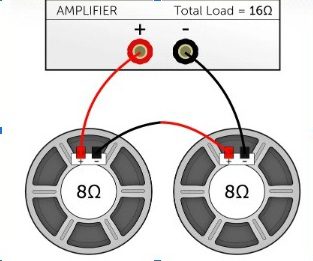So, while setting up an audio system, one of the important decisions you’ll have to make is which method of connection to use – Parallel or Series. In parallel connection, the speakers are connected to a single source but in a series connection, they are connected like a chain link. Each method has its own strengths and drawbacks. So, you have to decide among them based on what you’re looking to achieve – clarity or volume. In this article, we are going to explore the key differences between series and parallel connections to assist you in comprehending and making an informed decision.
What Are Parallel Speakers?
In this configuration setup, all the positive terminals of an audio system are connected to each other and the same with the negative terminal as well. This arrangement creates a parallel connection between the speakers, which is where the name comes from. Here, the impedance gets divided among the connected speakers so higher the number of speakers, lower will be the overall impedance. The set up process of parallel speakers is quite simple and you can even connect speakers with mismatched impedances. But there is a risk damaging the speakers because of unequal power distribution.
What Are Series Speakers?
In this type, connections are set up like creating a chain of speakers where the positive terminal of one speaker is hooked up to the negative terminal of another. This arrangement creates a circuit where the speakers are in-series with one another, which is where the name comes from. Here, the complete system’s impedance must be the same as the sum of the individual speaker impedances. This means that matching the speaker impedances is important – if they’re mismatched, you might run into problems with unequal current flow and potential damage to your speakers. In contrast to parallel connections, series speaker connections can bear higher voltages and provide enhanced protection for the amplifier. However, it’s worth noting that the wiring can be a bit more complex, and the power handling capabilities of the system may be reduced compared to parallel connections. Below is an image representing the comparison between parallel and series speakers
Benefits of Parallel Connections
Below are some of the main advantages of parallel speaker connections.
Simple wiring set up process Matching speaker impedances not required Can handle more power More efficient Better sound quality Less distortion Overall system impedance is lower
Drawbacks of Parallel Connections
Below are some of the main disadvantages of parallel speaker connections
Less voltage handling capacity Higher risk of overdriving single of multiple speakers, especially if they unmatching impedances Higher risk of speaker damage, especially if the unmatching impedances create unequal power distribution Can result in less overall system impedance and lower protection of the amplifier
Benefits of Series Speaker Connections
Below are the main advantages of having series speaker connections
High overall system impedance so it can ensure protection to the amplifier Can handle high voltage capacity Simple wiring setup Less distortion and better noise rejection Suitable for connecting speakers with different impedances
Drawbacks of Series Speaker Connections
Below are the main disadvantages of having series speaker connections
Matching the speaker impedances can be difficult Less power handling capacity If impedances are not matched, unequal volume levels and possible speaker damage can occur due to uneven current flow. Additional components such as transformers or resistors may be needed to match speaker impedances. High system complexity and price
Parallel Vs Series Speakers – Which One is A Better Option?
Parallel speaker connections ensure better efficiency, power handling ability and sound quality. But may produce unwanted distortion and lower the overall system impedance, which can affect your listening experience. When it comes to series speaker connections, they provide increased system impedance and voltage handling capabilities. But remember that, you have to connect matching impedances and may not have the same power handling capabilities as their parallel counterparts. To make the right choice among these two options, you have to consider certain audio system specifications that include efficiency, overall system impedance, and power handling. If you’re not sure what to do, consult a professional or use technical resources to help you make the right choice.
In summary
Both parallel and series speaker connections have their own set of advantages and disadvantages. Choosing between them depends on what you want to achieve with your audio system. Both options can work well, but it is crucial to weigh up the pros and cons of each before deciding. Ultimately, the goal is to pick the best configuration for your specific needs. Comment * Name * Email * Website
Δ






![]()